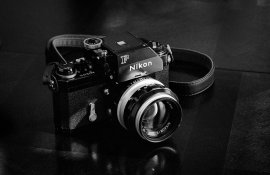flavio81
Member
Thank you for your well written and useful post, it's very much appreciated and I think you understand what I look for in a camera.
Hi Camera-Enthusiast,
The posts above suggest a Nikkormat FT2. I had one, in black, but at the end I kept the Nikon FE and the Nikon F (and later sold the FE.) The FT2 is beautiful (in black) and really sturdy, but these were my problems with it:
- Lens changing is slow, because you MUST set the lens to f5.6 to fit it in or to take it out. This because of the rabbit-ear system in the FT/FT2. Moreover, to mount a lens you must make sure the aperture coupling pin is set fully to the right. So to mount a lens, those are usual the steps:
a) verify that the aperture coupling pin far to the right
b) set your lens to f5.6 (and this, sometimes, while you have the lens and camera in your hands -- be careful not to drop the lens!)
c) mount the lens by aligning correctly with the aperture coupling pin and turning the lens left
d) twist it to minimum aperture
e) twist it to maximum aperture
f) Now you can enjoy. But set your lens to the desired aperture, because the previous aperture was disturbed.
As you see, there are five (5) steps. The competing Canon cameras (from 1971 on) had the following procedure:
a) couple the lens to the camera, by pressing the lens against the mount
b) twist the breech-lock ring {in fact step (a) automatically twists it a little bit}
c) Enjoy. The lens aperture setting was never disturbed.
Two steps.
Anyways, the Nikon AI cameras have no such problem. The plain Nikon F has no such problem either, because of no meter coupling.
The Photomic T and Photomic TN (for the Nikon F) use these "rabbit ears" as well, but they don't require you to set the lens to f5.6 to move it in and out of the camera.
- The shutter speed lever is not so easy to grab; sometimes it could end in an angle where it is ackward to grab and move. In this respect i find the conventionally-located shutter speed dial (of the other Nikons) much more ergonomic.
- The shutter, a vertical Copal, is noticeably more rough (more vibrations) than the horizontal shutter of the Nikon F. In other words, vibrations are noticeably stronger than in the Nikon F. The Nikon F's shutter curtain is remarkably smooth, in fact I think it was Celestron (telescope manufacturers) who did some vibration tests in the 70s and chose the Nikon F as the ideal camera to mate with their longest telescopes. Now, having said that, I certainly got sharp pictures from my Nikkormat in most (or all) occasions, in fact one of my best picture was taken with a Nikkormat, so it's more of a "feel" problem than an actual, practical problem.
- Photometer. The Nikkormat photometer uses a ring resistor (around the lens mount) that is doomed to failure just as in the Photomic finders. The first sign of aging is a jumpy meter needle. This can be sometimes cured by a technician, which will clean the contacts, but eventually the thing wears since the brushes move against the resistor surface:
a) whenever you mount a lens and do the "Nikon Twist" (i.e. moving from f5.6 to f22 and then to f1.4 and then to the chosen aperture), which is mandatory
b) whenever you adjust aperture
c) whenever you adjust shutter speed
So, you see, this resistor is always doing a heavy duty job. TEST THE CAMERA before buying, for example only in certain speeds you will find the "jumpy meter needle" syndrome while other speeds may be fine. So try the meter at all speed/aperture ranges.
- Lens compatibility (sort of): For AI lenses without the "rabbit ears". You can mount them in the FT2, of course, but for correct metering you need to move the FT2's meter coupling pin totally to the left (or right? can't remember). Then you meter using stop-down metering. So far, so good.
The problem is that very often, in my experience, your fingers will unintentionally move the meter coupling pin, thus, messing down the meter reading without you noticing it.
If all your lenses have the "rabbit ears" then there's no problem, of course.
- Photometer. The CdS meter in the Nikkormat is slow to stabilize in indoors/low light (most CdS meters are.) If you really care for in-camera metering, the meter on the FE is vastly quicker and better.
- Noise. The Nikon F is quieter. The Nikkormat gives a satisfying (but loud) "Ka-chunk!" sound.
All in all I liked my FT2, but I did had problems with the above issues. Mostly, time lost due to the awkwardness of having to switch hand positions to grab the shutter speed dial. And the slowness of lens-changing. I sold the FT2 and got the FE, and I liked the FE way more.
Last edited by a moderator:














